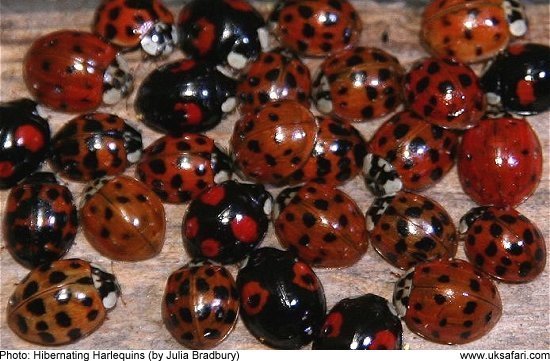How to Remove Harlequin Ladybirds from Your Home
Harlequin Ladybirds > How to Remove Harlequin Ladybirds from Your Home >

Here in the UK Harlequin Ladybird numbers have now swelled to a size where they are becoming a problem. Here's some evidence from our inbox:
"We seem to be invaded by ladybirds, after a while they seem to congregate in the corners of ceilings, they look as they are all dead. are they dead or hibernating , what is their lifespan. when will they go away"
"I was wondering if I could ask your advice on ladybirds? I noticed that there was a congregation of them in my bedroom near the top corners of the windows. When the sun came out, a few of them disappeared but there are still groups of them there. What should I do with them? I don't want to simply put them outside, but at the same time, I don't want so many in my house. Do you have any suggestions?"
"My 90 year-old mum, and her neighbours, have a problem with ladybirds. Masses of them hibernate in the window frames, door frames and lofts. I'm not exaggerating - last summer I knocked on the front door of her neighbour and when it was opened, an unusual event because the family only use the back door door, hundreds of ladybirds in the doorframe were startled awake. My mum is freaked out by constantly finding ladybirds all over the house. Can you think of a way that I can get the ladybirds out of the house without killing them?"
Harlequins hibernate in all manner of sites, from cracks in rocks and trees, to sheds, garages, porches and cracks around windows and doors. They also often end up inside houses.
Some people get rid of them with a vacuum cleaner, but if you find some hibernating in your house and want to remove them humanely you can use a pocket pooter or coax them into a container using a soft paint brush (depending on how many there are).
If you release them (remember they're a threat to our native species), do it a long way from the house and wash the areas of the house where they settled with a strong detergent. This is to remove any ladybird scent left by the insects, which they use to find their way back.
Some other Ladybird species, such as the Two-Spot, and 7-Spot can also be found hibernating in buildings, and sometimes in large groups alongside Harlequins. It's best to release them outside, either on a warm day, or in a suitable frost free out house, such as a garage or shed, where they can spend the rest of winter without too much disturbance.
Related Pages
- UK Safari Harlequin Ladybird Fact File
- UK Safari Ladybirds Section
- UK Safari Beetle Section
- UK Safari Invertebrate Section
- UK Safari News
